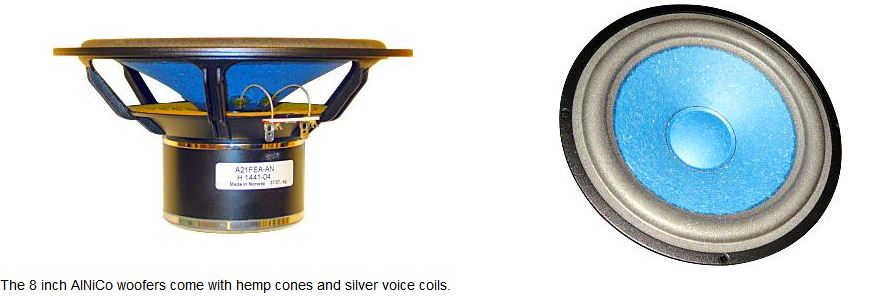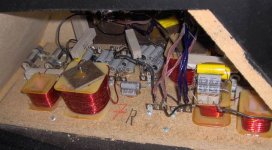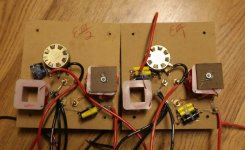Hi Everyone,
I remember at some point in the 90's Polk or Carver kind of created the high mass, high excursion subwoofer. The idea was to marry a high power amplifier with these relatively small drivers with giant rolled surrounds.
They seem to have gone largely out of favor, why I don't really know. They seemed ideal for the satellite/subwoofer market that was also pretty much in vogue.
But anyway, while looking up information on one of the speakers I heard with just outstanding bass I learned something. The Snell A/III's woofer was 'doped' or rather, modified with a large mass of resin poured in the ring where the dust cap and cone meet.
Was it in fact Snell who started this trend? I wonder if they did anything that we can't buy off the shelf today. What I do remember is just how completely effortlessly the speaker would seem to be breathing all of the air of the room at once. Ahh, good old days of Tandberg, Kyocera and Sumo.
Anyway, ideas?
Thanks!
Erik
I remember at some point in the 90's Polk or Carver kind of created the high mass, high excursion subwoofer. The idea was to marry a high power amplifier with these relatively small drivers with giant rolled surrounds.
They seem to have gone largely out of favor, why I don't really know. They seemed ideal for the satellite/subwoofer market that was also pretty much in vogue.
But anyway, while looking up information on one of the speakers I heard with just outstanding bass I learned something. The Snell A/III's woofer was 'doped' or rather, modified with a large mass of resin poured in the ring where the dust cap and cone meet.
Was it in fact Snell who started this trend? I wonder if they did anything that we can't buy off the shelf today. What I do remember is just how completely effortlessly the speaker would seem to be breathing all of the air of the room at once. Ahh, good old days of Tandberg, Kyocera and Sumo.
Anyway, ideas?
Thanks!
Erik
Hi,
They are not out of favour at all. In fact most subwoofers easily
qualify as high mass drivers, that only only achieve their rated
power handling via low efficiency and the high excursion it allows.
FWIW the ratio of driver Fs to its Vas is totally dependant on mass,
for a given effective cone area, and all good subs are high mass.
rgds, sreten.
They are not out of favour at all. In fact most subwoofers easily
qualify as high mass drivers, that only only achieve their rated
power handling via low efficiency and the high excursion it allows.
FWIW the ratio of driver Fs to its Vas is totally dependant on mass,
for a given effective cone area, and all good subs are high mass.
rgds, sreten.
I'm not sure the Snell type 8" woofers were high mass at all.

High Qms, or low mechanical loss for sure.
http://www.diyaudio.com/forums/multi-way/147632-classic-monitor-designs-17.html#post4358469

High Qms, or low mechanical loss for sure.
http://www.diyaudio.com/forums/multi-way/147632-classic-monitor-designs-17.html#post4358469
I'll say it again. Snell didn't use high mass cones or acoustic suspension. In fact they were bass light.
The real trick is paper or plastic Kapton voice-coil formers, which have high Qms.
Aluminium formers, even slit, damp the Qms to around 2.0. Increased power handling but a less detailed sound. Eminence usually use Kapton too.
I quote Joachim Gerhard:
The real trick is paper or plastic Kapton voice-coil formers, which have high Qms.
Aluminium formers, even slit, damp the Qms to around 2.0. Increased power handling but a less detailed sound. Eminence usually use Kapton too.
I quote Joachim Gerhard:
- Many "old" paper woofers still sound astonishingly good compared to modern drivers?
- Oh, yes. We have not always went to the better. What many driver manufacturers have done the last years, is to increase the damping to make the frequency response more flat. But some old drivers, like the famous 6,5" paper woofer that Jan Paus at Seas made several years ago, (The Seas CA 17 RCY, ed. note) was optimized for low loss. So they made a compromise between frequency response and sensitivity. This driver was very good, and was used by Wilson Audio for many years. Later, in the 80's, manufacturers started to add more mass, they added more damping, and they made surrounds with high loss. That gave an extremely flat frequency response, but also a lot of energy storage. This compared, the old drivers were much quicker. They had some resonances, but you could get rid of that in the crossover. It was this run for flat response that gave a lot of modern drivers this dull, uninteresting sound. And you can also measure higher second and third harmonic distortion in some of them. If you compare the on-axis response between an old and new driver; you will see that the energy in the treble is far higher than in the new drivers. These so-called "modern" drivers often has a Qms of maybe 0.8 or 0.6. The old drivers had Qms values of maybe 5 to 7! We found that drivers with a very high mechanical Q sound more open, more clean and dynamic. And when you look at it, you find it is very simple, because they have less loss. The surround is easier to move, the spider is better constructed, they have better air flow, higher sensitivity. So a high mechanical Q is a very good indicator of energy storage behavior. This is one of our secrets. One of the many!
I was definitely not thinking about the small woofers.  I was talking about the 12" woofers in the A/III
I was talking about the 12" woofers in the A/III
and by "high mass" it may be relative to what was off-the-shelf.
Here's an image of a woofer that had resin poured on it to increase the mass:
from the site at http://www.snell.no/forum/index.php?topic=1411.0
Now, Steve, would you happen to be able to get your hands on the T/S parameters of the finished driver? That would be cool. I've not been able to find anyone who has measured the resulting woofer.
That would be cool. I've not been able to find anyone who has measured the resulting woofer.
Best,
Erik
and by "high mass" it may be relative to what was off-the-shelf.
Here's an image of a woofer that had resin poured on it to increase the mass:
An externally hosted image should be here but it was not working when we last tested it.
from the site at http://www.snell.no/forum/index.php?topic=1411.0
Now, Steve, would you happen to be able to get your hands on the T/S parameters of the finished driver?
Best,
Erik
Erik, I'm not a guy who lives in the past. 
Troels Gravesen, who has dedicated his life to good sound, has nagged SEAS into designing a good woofer:
JA8008-HMQ
It's not the mass that matters, more the rigidity at the centre of the cone if you go with the resin idea. Dustcaps are terrible things, if you understand the cone idea at all.
I can't claim I understand all of it. But I took something away from Robin Marshall's ideas.
Troels Gravesen, who has dedicated his life to good sound, has nagged SEAS into designing a good woofer:
JA8008-HMQ
It's not the mass that matters, more the rigidity at the centre of the cone if you go with the resin idea. Dustcaps are terrible things, if you understand the cone idea at all.
Atkinson: You say that you think a cone tweeter might be a better way of going about it?
Marshall: Yes I do. Because when a dome goes into breakup, it's utterly, totally finished. Uncontrollable. That's it. There's nothing more to be had. When a cone goes into breakup, all that's happening, providing you can control it, is that the radiating area is diminishing. It's much easier to control that. There's a lot of work to do, of course. I wouldn't like to say that you can just take a sheet of paper and design a cone tweeter which is going to be a world-beater. But I'm sure there's a lot of scope. I shouldn't say this, should I? I should just go out and do it.
Read more at Robin Marshall: A Modicum of Genius Page 4 | Stereophile.com
I can't claim I understand all of it. But I took something away from Robin Marshall's ideas.
I advocate reading the classics before attempting new stuff. Lot to learn there. But I was a bit off-topic last night if you want to talk about high mass bass units.
Acoustic Research used to add stuff like copper wire rings near the dustcap to add mass to acoustic suspension drivers. Perhaps resin can reduce the Fs too.
That's all very well for a bass that doesn't have much midrange duties, but why bother? Unless you desperately need a small inefficient box. No magic there.
Troels had a look at a Snell A3i, so I think I now know what you are talking about:
Snell A3i
I also have a snap in my archives of a 3 way Snell A crossover. Weird, or WHAT! Also a Snell E, which is the 8" bass plus 1" tweeter.
Acoustic Research used to add stuff like copper wire rings near the dustcap to add mass to acoustic suspension drivers. Perhaps resin can reduce the Fs too.
That's all very well for a bass that doesn't have much midrange duties, but why bother? Unless you desperately need a small inefficient box. No magic there.
Troels had a look at a Snell A3i, so I think I now know what you are talking about:
Snell A3i
I also have a snap in my archives of a 3 way Snell A crossover. Weird, or WHAT! Also a Snell E, which is the 8" bass plus 1" tweeter.
Attachments
They seem to have gone largely out of favor, why I don't really know.
Three letters: DSP.
For a given motor strength, all adding mass does is cut efficiency. That leads to a perception of greater extension, but only because the top end is reduced.
Why reduce the efficiency of the driver when you can use DSP to equalize the response and limiters to keep that extra upper bass headroom?
Peter Snell wasn't looking for 'fast' bass when he started adding mass to the RCF woofers in the form of resin poured around the DC. He was looking for lower Fb at the expense of efficiency. One thing he probably didn't anticipate was spider sag that occurs after many years because of the vertical orientation of the woofer in the model A cabinet.
With that much mass it would be hard for the spiders not to deform, regardless of orientation.  Still I always liked the bass.
Still I always liked the bass.  Let me ask this another way. With modern drivers, have you heard reasonably priced alignments that sounded as good, or better? What would you point me to?
Let me ask this another way. With modern drivers, have you heard reasonably priced alignments that sounded as good, or better? What would you point me to?
I'd point you to:With that much mass it would be hard for the spiders not to deform, regardless of orientation.Still I always liked the bass.
Let me ask this another way. With modern drivers, have you heard reasonably priced alignments that sounded as good, or better? What would you point me to?
Data-Bass
Great comparative data on a variety of drivers in various price ranges.
With the increased excursion capabilities of current drivers, the cone mass has usually been increased to reduce distortion, and to keep the cone from actually buckling or tearing up. Many drivers also use double spiders to better keep the coil(s) in alignment.
The Snell A/III had in room response of -3dB at 24 Hz, and the woofers were crossed over at 275 Hz, giving a combination of very deep bass (for the time) and smooth phase response through the "punch" range. Super solid, heavy cabinet construction helps too.Hi WEltersys!
Good resource, but I don't know what I heard.That is, what I'd love to have is a brand knew Snell A/III to measure so I could tell what it was about it I liked so much, then I could go get more modern drivers.
Best,
Erik
Or maybe it was the rear firing tweeter that caught your ears ;^)..
- Status
- This old topic is closed. If you want to reopen this topic, contact a moderator using the "Report Post" button.
- Home
- Loudspeakers
- Multi-Way
- High Mass Woofers, Did Snell Start it?

